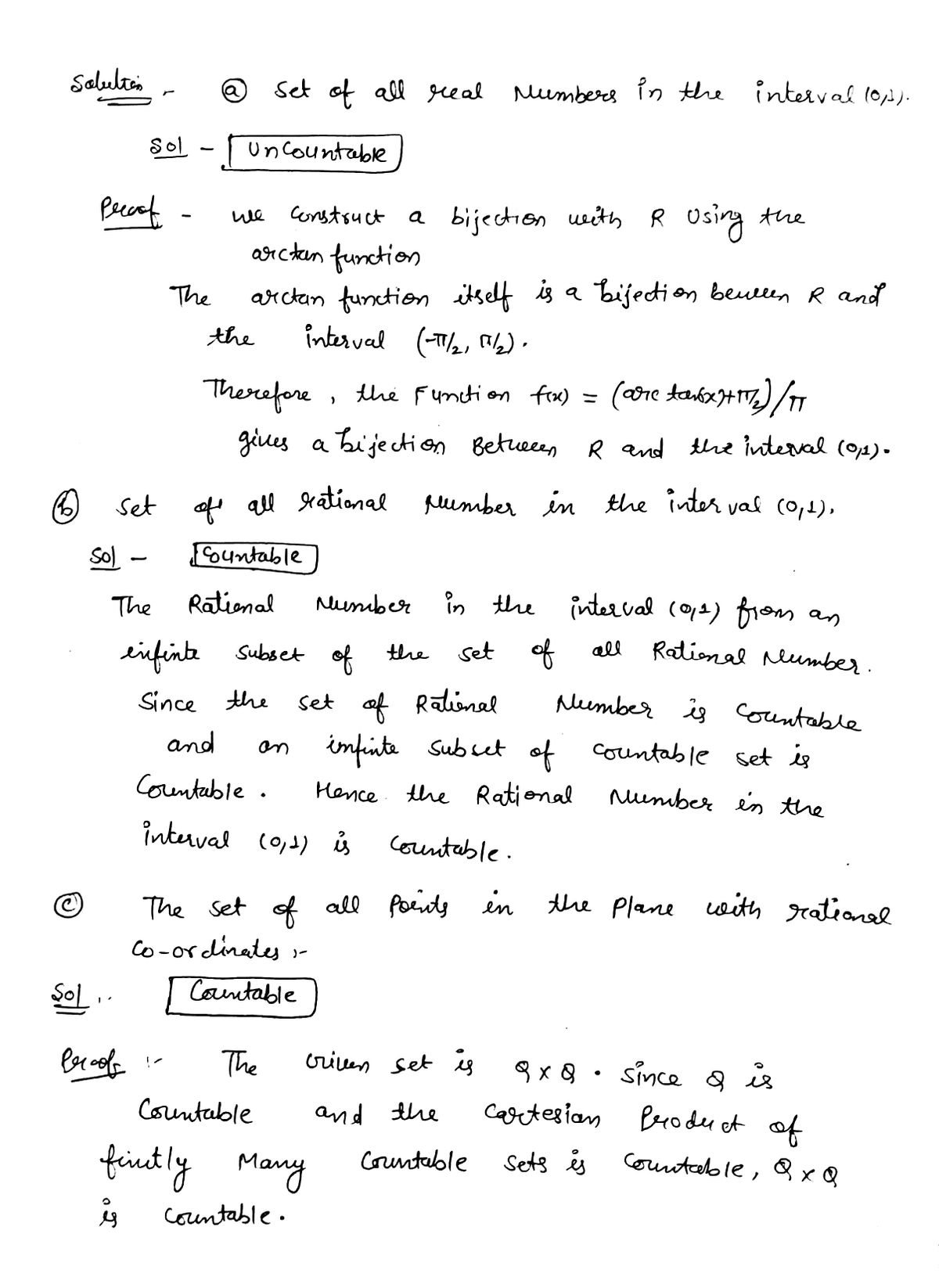Problem 2. The following items are intended to develop a "feel" for countable and uncountable sets. In each case, determine if the set is countable or uncountable and justify your answer. Here are some ways to establish countability or uncountability: • Establish a bijection to a known countable or uncountable set, such as N, Z, Q or R, or a set from an earlier problem. . Establish a bijection to a subset of a known countable set (to prove countability) or a superset of a known uncountable set (to prove uncountability). Build up the set from sets with known cardinality, using unions and cartesian products, and use the results on countability of unions and cartesian products. Use the Cantor Diagonal Argument to prove that a set is uncountable. a) The set of all real numbers in the interval (0, 1). Hint: Use a standard calculus function to establish a bijection with R. b) The set of all rational numbers in the interval (0, 1). c) The set of all points in the plane with rational coordinates. d) The set of all functions f: {0,1} → N. e) The set of all functions f: N→ {0,1}.
Problem 2. The following items are intended to develop a "feel" for countable and uncountable sets. In each case, determine if the set is countable or uncountable and justify your answer. Here are some ways to establish countability or uncountability: • Establish a bijection to a known countable or uncountable set, such as N, Z, Q or R, or a set from an earlier problem. . Establish a bijection to a subset of a known countable set (to prove countability) or a superset of a known uncountable set (to prove uncountability). Build up the set from sets with known cardinality, using unions and cartesian products, and use the results on countability of unions and cartesian products. Use the Cantor Diagonal Argument to prove that a set is uncountable. a) The set of all real numbers in the interval (0, 1). Hint: Use a standard calculus function to establish a bijection with R. b) The set of all rational numbers in the interval (0, 1). c) The set of all points in the plane with rational coordinates. d) The set of all functions f: {0,1} → N. e) The set of all functions f: N→ {0,1}.
Advanced Engineering Mathematics
10th Edition
ISBN:9780470458365
Author:Erwin Kreyszig
Publisher:Erwin Kreyszig
Chapter2: Second-order Linear Odes
Section: Chapter Questions
Problem 1RQ
Related questions
Question

Transcribed Image Text:**Problem 2.**
The following items are intended to develop a “feel” for *countable* and *uncountable* sets. In each case, determine if the set is countable or uncountable and justify your answer.
**Here are some ways to establish countability or uncountability:**
- Establish a *bijection* to a known countable or uncountable set, such as \( \mathbb{N}, \mathbb{Z}, \mathbb{Q} \) or \( \mathbb{R} \), or a set from an earlier problem.
- Establish a bijection to a *subset* of a known countable set (to prove countability) or a *superset* of a known uncountable set (to prove uncountability).
- Build up the set from sets with known cardinality, using unions and cartesian products, and use the *results on countability* of unions and cartesian products.
- Use the *Cantor Diagonal Argument* to prove that a set is uncountable.
**a)** The set of all real numbers in the interval \( (0, 1) \).
*Hint: Use a standard calculus function to establish a bijection with \( \mathbb{R} \).*
**b)** The set of all rational numbers in the interval \( (0, 1) \).
**c)** The set of all points in the plane with rational coordinates.
**d)** The set of all functions \( f : \{0, 1\} \to \mathbb{N} \).
**e)** The set of all functions \( f : \mathbb{N} \to \{0,1\} \).
Expert Solution
Step 1

Step by step
Solved in 2 steps with 2 images

Recommended textbooks for you

Advanced Engineering Mathematics
Advanced Math
ISBN:
9780470458365
Author:
Erwin Kreyszig
Publisher:
Wiley, John & Sons, Incorporated

Numerical Methods for Engineers
Advanced Math
ISBN:
9780073397924
Author:
Steven C. Chapra Dr., Raymond P. Canale
Publisher:
McGraw-Hill Education

Introductory Mathematics for Engineering Applicat…
Advanced Math
ISBN:
9781118141809
Author:
Nathan Klingbeil
Publisher:
WILEY

Advanced Engineering Mathematics
Advanced Math
ISBN:
9780470458365
Author:
Erwin Kreyszig
Publisher:
Wiley, John & Sons, Incorporated

Numerical Methods for Engineers
Advanced Math
ISBN:
9780073397924
Author:
Steven C. Chapra Dr., Raymond P. Canale
Publisher:
McGraw-Hill Education

Introductory Mathematics for Engineering Applicat…
Advanced Math
ISBN:
9781118141809
Author:
Nathan Klingbeil
Publisher:
WILEY

Mathematics For Machine Technology
Advanced Math
ISBN:
9781337798310
Author:
Peterson, John.
Publisher:
Cengage Learning,

